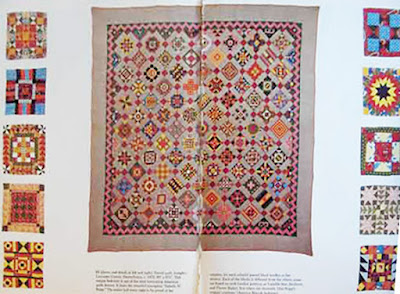Small quilt shown in
Classic Crib Quilts and How to Make Them
by Thomas. K. Woodard & Blanche Greenstein
I indexed the pattern in my Encyclopedia of Applique
with the 4+4 patterns.
#19.35
Tulip Cross
The pattern was also in Safford & Bishop's book
as Princess Feather and Tulip
The Princess Feather & Tulip pictured there is this one in the collection of the Henry Ford Museum,
made in Ohio by an unknown quiltmaker according to the caption.
I wish we had a 19th-century name for the pattern because it was definitely a 19th-century item.
Date inscribed 1856 by Mary E. Byrod Fortenbaugh (1832-1929)
Collection of the Illinois State Museum
Halifax, Dauphin County, Pennsylvania
The Museum has five quilts by Mary in their collection.
See all five by going to the Quilt Index and typing
Byrod in the top right search box.
Cover of Quilters Newsletter in 1997
It's a big block, usually seen as a four-block set.
Nice geometry, fills the square block well
The feather's curve helps.
This one may be late-19th century.
Although sometimes the feather is straight,
a variation. This one looks fairly recent.
Then we get into the variations:
Not necessarily a tulip
Quiltmakers could make the pattern simpler or more complex.
Christina Meyers added a lot in the corners of each block.
Date-inscribed 1860 in the collection of the
International Quilt Study Center & Museum
# 2015_053_0001
Date-inscribed 1859 by Huldah Caroline Deat.
The red flower on the feather looks like a botanical Prince's
Feather.
A sad old top with coxcomb instead of tulip,
Another pattern from mid to late 19th century.
Here's one earlier and in much better shape from Julie Silber's inventory.
Hard to say if the feathers are going north/south or on the diagonal here.
Another take is putting the curling feathers in the corners as in this
example by Christinia Hathaway
from the Connecticut Project.
Found in Connecticut but made in Ohio
Sunflowers and a Caesar's Crown for the center.
Moving the curving feather to the corners tends to compress the design.
It fits into a smaller space.
This one is a nine-block.
A relative also from the Connecticut project.
Seen at Quilt Market in Chicago I believe
Here's the latest of the vintage examples.
Pastel prints with red blanket stitch,
strangely appealing.
No curve in this one
Louise Lynn from the Carlson Four Block Collection at the
International Quilt Study Center & Museum
#2012_008_0005
Also IQSC
This is a different pattern though. We are digressing.
If you'd like a pattern for the tulip cross crib quilt the
Woodard & Greenstein book has one.
Betty Jefferis won a prize for her machine appliqued
reproduction quilted by Mattie Troyer.
And here's another pattern option from the cover of Quilters Newsletter.
Print it 8" and double it for a 20" block.






















































